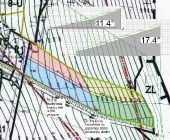Kay Sue wrote:My dilemma is that I do not know where to start and once I do start, can I put down a quick cover crop to help hold the moved soil in place over the winter? We are near the capitol so not the worst snow. Our grade isn't steep, just enough right this moment that what rain we get is washed down and not absorbed.
Hi Kay, welcome to the forums!
You are
absolutely correct that
cover crops or other ground cover should be established as soon as possible after moving earth in order to prevent erosion. So when digging swales, be sure to
save that nice healthy topsoil, and replace it back on top before sowing cover crops or grass seed etc. to help those plants live their best lives, rather than growing in subsoil!
In addition to cover crops, let's dig in and cover the basics for anyone reading this who may be brand new to swales
 Why swale?
Why swale?
As we can see from that photo you posted, swales are
useful for tree production. Trees, by the way, can perform some of the same functions as swales: "
slowing, spreading, and sinking" water across a landscape. But swales truly shine in dry climates which receive large sporadic bursts of precipitation. That precipitation can be saved in the most efficient location possible -- in the soil where we want plants to grow.
What's a swale?
We see in that picture that a permaculture swale is simply a
level ditch (the earthworks 'cut' portion, depicted as that dashed water level line)
followed by a berm (the earthworks 'fill' portion located immediately downhill of the ditch).
Permaculture swales are always built on contour of the land, just like the lines of a topographic map. Therefore,
a great place to start is thoroughly understanding the contour of your land. Bunyips, A-frames, laser levels, and other tools of the trade are used to supplement understanding gleaned from maps or via walking the landscape.
How does it work?
During big precipitation events, the ground uphill of the swale holds what it can, and excess water flows downhill. By the way, if there's plenty of organic matter in the soil, the ground can hold a lot more moisture, so be sure to charge your landscape with organic matter when possible! Now, if that excess water flows down slope too quickly, it picks up soil and erosion happens, carrying particles downhill. Enter the swale...The "slowing and spreading" functions happen because that ditch and berm are level and on contour. If they were instead improperly built at a slope across the landscape, after saturation, that water might accelerate downhill and risk erosion. As the water slows down, it deposits silt and any organic material it may have picked up, creating a good place for future plants, and perhaps a level walking path in the distant future.The "sinking" function of a swale happens because, unlike some diversion ditches, the permaculture ditch portion of a swale is not compacted. The ditch portion is designed primarily to soak that water down into the ground over time, and, once saturated, the water journeys sideways along the swale, too.The recharged groundwater helps all the growies downhill, like those "productive trees" or that garden patch.
A good design may consider:
Where do we want to recharge the landscape to grow things?Where do we not want to recharge the landscape (like at the foundation of a house!)How much catchment (area uphill) are we harvesting water from?What kind of rainfall events will likely happen?How much volume of water is created...what portion of this will run off, and how much can or should the swale carry?Spillway considerations -- Where will the swale system discharge water, if it is filled beyond its brim? How best can we use this water e.g. ponds; dams; streams returning water to its natural courseBeneficial plant element, animal element, and access considerations and interactions
If you are curious about earthworks construction and professional design considerations, check out
The Permaculture Earthworks Handbook, by Douglas Barnes. Or just look around the forums, as I'm sure someone has some good photos of permaculture design and swale construction.
Post your follow up questions below and someone with more experience can chime in!






